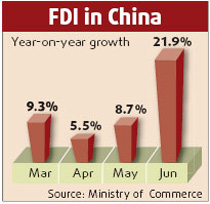Li Shi, director of the Income Distribution and Poverty Research Center at Beijing Normal University and one of China's leading scholars on inequality and poverty, started his first non-governmental investigation on income in 1988 and his fourth this August. With the rapid development of society, his study is more and more important.
On August 15, under a unified arrangement of the National Bureau of Statistics of China (NBS), the Beijing Municipal Statistics Bureau also began an investigation of the economic status of 30,000 urban families in Beijing.
In addition to salary, more than 400 items are listed in the survey, including income from real estate, interest, stock bonuses, IPR, charity, support from children, and other donations. NBS takes a detailed survey of 60,000 families every three years from about 300,000 families who are more casually investigated. This time, the NBS plans to sample more than 500,000 families nationwide, which is the largest of its kind to date.
Many scholars believe the income gap is widening in China, and several ministries and commissions have started to focus on this social problem. The Political Bureau of the Central Committee of the Communist Party of China studied the idea of reforming the distribution system during a meeting in May last year.
Now, the State-owned Assets Supervision and Administration Commission (SASAC) of the State Council and the Ministry of Labor and Social Security have also started working on this problem. Su Hainan, director of the Labor Salary Institute under the MOLSS, explained that the SASAC recently made an investigation into the income of the workers in SOEs (State-owned Enterprises) and MOLSS has made efforts to raise the salaries of average employees.
Survey: difficult to be precise
Li Shi and his colleagues hope their 10,000-person investigation will reflect the changes in the income gap over five years, especially the living condition of the disadvantaged, such as people living on subsistence allowances and migrant workers.
The statistics released by the NBS in 2005 revealed the salaries of urban employees in the high-income bracket were approximately five times as high as those in the low-income bracket. Taking into account welfare and subsidies, the income disparities could be even greater.
However, there are no unified statistics on the income difference between classes. The latest statistics were released two years ago and showed that the urban income rate between the richest level and poorest level had enlarged from 5.1:1 in 2002 to 5.3:1 in 2005.
Li Shi explains that it's difficult to get an exact number of people in each income bracket, which leads to inaccurate results for the rate. But the recorded statistics already show that the income gap between the urban areas and the rural areas and among different classes of urban people have all widened.
Wang Xiaolu, deputy director of the National Economic Research Institute under the China Reform Foundation, recently published his report on grey income and income disparity.
He used the theory of the Engel index, which is a measure of what portion of a person's income goes for food, and uses the statistics of their food expenditure to deduce their incomes. He came to the conclusion that 10 percent of the richest urban people earn 31 times as much as the 10 percent of the poorest urban people; the rural rich earn 55 times as much as rural poor.
"The distortion of the previous results is owing to the considerable amount of grey income, which wasn't included in the survey," Wang said. "The reason for the income gap is not the market economy itself, but rather the corruption and grey income in the unsound social system," he added.
A section chief of NBS said most respondents left the "grey income" column blank in its previous survey. He feels it is inevitable for the upper class to report their income unfaithfully, but that it's not as serious a problem as Wang Xiaolu believes.
To make the survey more precise, NBS plans to cooperate with other departments and social science research institutions.
Reform: still brewing
The Chinese government plans to narrow the income gap by raising the minimum wage and slowing down the growth of high salaries. The income gaps between urban and suburban, rich and poor, are growing quickly.
Current statistics provided by Li Shi show that in 2002, 10 percent of the people in China acquired nearly 32 percent of the country's income; this ratio grew 1.2 percent from 1995.
Early last year, the income gap ratio in China between urban and suburban residents reached about 3.3:1; globally, there were only four countries with ratios above 2.5:1. Lin Yifu, professor from the China Center for Economic Research of Peking University, warned the income gap between urban and suburban residents would reach a dangerous level of 4.1:1 if it continues to grow at the current rate.
Experts believe the country needs to restructure its distribution system to change the current income inequality. "The country should not propel its development simply by the growth of Gross Domestic Product," said Wang Yiming, vice president of the Academy of Macroeconomics Research of the National Development and Reform Commission.
According to Wang, the growth of government revenue outruns the growth of individual income every year, which causes an imbalance between over-heated investment and inadequate consumption. The government should distribute more revenue to public works like education and health care, said Wang.
Income balance should be achieved from a tightened surveillance on the management of public funds, according to research conducted by Liu Suhua and her colleagues from the Party School of the Central Committee of Communist Party of China. In recent years, some officials and business tycoons in monopolized industries have taken advantage of legal loopholes to embezzle public funds and make themselves big fortunes.
(China.org.cn by Chen Lin and Wu Jin August 24, 2007)


